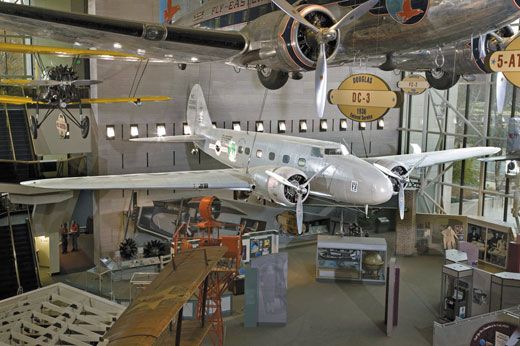In the Museum: The Original Airliner
The Boeing 247 was the Dreamliner of its day.
/https://tf-cmsv2-smithsonianmag-media.s3.amazonaws.com/filer/Museum-Boeing-247D-FLASH.jpg)
When Boeing introduced its 787 Dreamliner, which was delivered to its first customer last September, the company may have been hoping for a reprise of its experience with an earlier revolutionary design.
On April 2, 1933, more than 15,000 spectators crowded onto Boeing Field in Seattle, Washington, to take a look at the world’s first modern airliner, the Boeing 247.
“The 247 was ordered in 1931, 1932, and that was the absolute pit of the Depression,” says Robert van der Linden, the curator of commercial aviation at the National Air and Space Museum. “Yet there were major breakthroughs in aircraft technology from 1927 to 1933, and they all kind of converged on the 247.”
The all-metal, low-wing monoplane featured retractable landing gear, and was one of the first airplanes to have controllable-pitch propellers and de-icer boots. The twin-engine airplane also required two pilots, “and from 1933 up until the Boeing 787, they’ve been building aircraft the same way,” says van der Linden.
“When the 247 entered service,” he continues, “it was 50 percent faster than the competition. That kind of leap doesn’t happen anymore. The competition was the Ford Tri-motor. It did 100 miles an hour; this did 150, almost 160.”
The sleek new aircraft could carry 10 paying passengers in addition to the mail, and cut seven hours off coast-to-coast flying time. “And unlike the Ford Tri-motor,” says van der Linden, “the 247 was equipped with the latest navigational devices, could fly at night, and had two-way radio and autopilot. And its heated cabin was more comfortable for passengers.”
But its low-wing (technically a mid-wing) design led to some problems. “When you climbed into the 247,” says van der Linden, “you’d bump your head for sure. And halfway up the aisle, you’d have to step across one of the main spars.”
The DC-2 came out in 1934, “and it was a low-wing design with a nice flat floor,” he continues. “The DC-2 was a much more comfortable airliner—and faster. And just like that, no one wanted Boeings anymore.”
But that’s not the end of the story. The Museum’s Boeing 247-D is important both as an aircraft type and as an artifact.
In 1934, air racer Roscoe Turner leased the 247-D that is now in the Museum’s collection from United Air Lines for the MacRobertson Race, an 11,000-mile marathon from England to Australia, sponsored by Australian candy maker MacPherson Robertson.
Turner made a major modification to the 247: He added extra fuel tanks, which increased the aircraft’s range to 2,500 miles. He and his crew were competing against 20 other aircraft, including three de Havilland DH 88 Comets, built especially for the competition, and a DC-2 flown by K.L.M. (Royal Dutch Airlines).
There were six required stops: Iraq, India, Singapore, and three Australian cities.
On October 20, after leaving Baghdad, the 247 was dangerously low on fuel, and the crew, heading for Allahabad, India, had veered off course. Suddenly, the city’s lights appeared on the horizon. With just five gallons of fuel remaining, “Roscoe set her down like a fly lighting on a juicy morsel of food,” navigator Reeder Nichols recorded in his log.
The navigational error caused a 5 1/2-hour delay; Turner came in third, behind a Comet and the DC-2.
The race results were big news. The fact that a rapidly obsolescent airliner performed as well as anything the British had built was a big shock, says van der Linden: “The Brits had nothing to compare it with. Nothing. It put U.S. manufacturing companies on the map.”
As the London Morning Post put it, “It has been realized with some astonishment that America now has in hundreds standard commercial aeroplanes with a higher top speed than the fastest aeroplane in regular service in any squadron in the whole of the Royal Air Force.”
After the MacRobertson Race, Turner returned the airplane to United Air Lines, which flew it until 1937, then sold it to the Union Electric Light and Power Company of St. Louis, for use as an executive aircraft. In 1939, the U.S. Department of Commerce bought the airplane and turned it over to the Civil Aeronautics Authority, which used it in a variety of tests until 1953, when the agency presented it to what was then the National Air Museum of the Smithsonian.
The 247-D is on display in the America by Air exhibition in the National Mall building.
